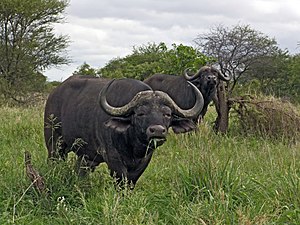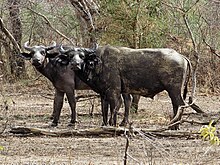Syncerus
| Syncerus | ||||||||||||
|---|---|---|---|---|---|---|---|---|---|---|---|---|

Cape buffalo ( Syncerus caffer ) in Kruger National Park |
||||||||||||
| Systematics | ||||||||||||
|
||||||||||||
| Scientific name | ||||||||||||
| Syncerus | ||||||||||||
| Hodgson , 1847 |
Syncerus , in German sometimes with the common name African Buffalo , is a cattle genusthat is widespread over large parts of Africa . For a long time the genus contained only one species with several subspecies, after a comprehensive revision of the hornbeams, four species of the genus are currently recognized. Their best-known species is the Cape buffalo ( Syncerus caffer ).
features
Within the genus there are significant differences between the species in terms of size and other characteristics. Large Cape Buffalo bulls ( Syncerus caffer ) can reach a shoulder height of 1.5 to 1.7 meters, a head-torso length of 2.4 to 3.4 meters and a weight of 1000 kilograms. The red buffalo ( Syncerus nanus ) of the Central African rainforests is significantly smaller than the buffalo with a head-trunk length of 1.8 to 2.2 m, a shoulder height of 1.0 to 1.3 m and a weight of 320 kg north or south and east bordering savannas .
While calves are still densely hairy, the coat becomes sparse with age, and old animals are almost naked. The color is mostly black in the Cape buffalo and red-brown in the red buffalo, but can also have different shades of brown in both types. Both sexes have wide horns. The ears are set under the horns. In the bull, both horns are connected by a bone shield that rests on the head. Cape buffalo have much larger horns than red buffalo.
distribution
The different species of Syncerus have only ever lived south of the Sahara. The species have adapted to a variety of habitats, from dense rainforest to open savannah. The Virunga buffalo ( Syncerus mathewsi ) can be found in the mountains up to an altitude of 3000 m. The populations are densest in wet savannahs with a good supply of drinking water, food (grasses) and thickets all year round.
Way of life

The animals live in herds that stay in one and the same territory for years and wander through it on fixed routes. The herds mostly consist of females and their young; males also join the herds during the mating season. There are also bachelor herds with juvenile bulls. A herd of Cape Buffalo consists of 50 to 500 individuals; Red buffalo apparently live in much smaller groups of eight to 20 animals. When there are several males in a herd, there is always a fight to establish the hierarchy. African buffalo have to drink once or twice a day, depending on the feeding situation, so that drought is very troublesome for them, as they then often have to cover further distances from the grass areas to the drinking places.
A calf is born after a gestation period of 340 days. Male cubs spend about two years with their mother before they have to leave the herd. Females, on the other hand, usually stay in the herd in which they were born for life. The animals reach sexual maturity when they are four or five years old. Their life expectancy is a maximum of 20 years in the wild and 30 years in zoos.
Enemies

In addition to humans, African buffalo have hardly any enemies. Lions , spotted hyenas and leopards occasionally try to capture young animals or sick individuals. However, the healthy animals of the herd know how to defend themselves effectively, so that some predators pay for such an attempt with serious injuries. However, individual adult African buffalos sometimes fall victim to lions or hyenas, and large Nile crocodiles also prey on animals when they cross rivers or come to the water to drink.
Numerous parasites such as ticks are known to be found in the skin of the buffalo. That is why you often see maggot chopper on the back of the buffalo, which feed on the parasites.
Buffalo and people
The Cape Buffalo of eastern and southern Africa has a reputation for being one of the most dangerous wild animals. Allegedly, cops are supposed to attack people again and again. However, it can be assumed that this is mostly due to cases in which farmers want to drive the animals off their land.
In the first half of the 20th century, the rinderpest introduced into Africa made buffalos rare in many countries or wiped them out completely. In South Africa it was now completely extinct, but has since been reintroduced into the country's national parks. The greatest threat to the African buffalo today is the increasing restriction of its habitat due to the high population growth in large parts of Africa.
As an animal of the Big Five , the African buffalo was also hunted on safaris. These big game hunts still exist today, but are nowhere near as common as they were in the early and mid-20th centuries.
Some of the Syncerus species belong to the reservoir hosts for Theileria parva , the causative agent of the East African coastal fever . This can lead to conflicts of interest with cattle farmers.
Names and systematics

The name component Kaffer in Cape Buffalo is a term for black people in South Africa and Namibia today as derogatory and racist; it comes from the Arabic word kafir , 'unbeliever'. The specific epithet caffer in the scientific name can no longer be changed according to the rules of the ICZN , since it was assigned by the first descriptor .
Originally only one species was recognized with the Cape buffalo, to which at least 30 subspecies were assigned by various scientists, but few of them were generally recognized. In agreement, three to five forms can be distinguished relatively clearly, which were perceived as independent subspecies of a species. Colin Peter Groves and Peter Grubb revised the hornbeams in 2011 and raised four of the five subspecies to species status. The fifth, commonly adopted subspecies, S. c. aequinoctialis , is morphometrically and historically identical to the Sudan buffalo. The following types are recognized today:
- Sudan buffalo or savanna or grass buffalo ( Syncerus brachyceros ( Gray , 1837))
- Cape buffalo ( Syncerus caffer ( Sparrman , 1779))
- Virunga buffalo ( Syncerus matthewsi ( Lydekker , 1904))
- Red buffalo or forest buffalo ( Syncerus nanus ( Boddaert , 1785))
The red buffalo is the smallest form, which is characterized by a reddish-brown color and short, backward-facing, barely curved horns. The Cape buffalo is significantly larger, with outward-pointing, curved horns and is also particularly dark black to gray-black in color. In the color between the two lie the Virunga and the Sudan buffalo, which also mediate between the red and Cape buffalo in terms of size and horn shape.
The genus Syncerus was scientifically introduced in 1847 by Brian Houghton Hodgson . He separated the African buffalo from the Asian forms of the genus Bubalus . As a distinguishing feature from the Asian buffalo, he saw the closely spaced horn bases in the African representatives. Previously, the African buffalo were often listed within the genus Bubalus . Hodgson named the Sudan buffalo ( Syncerus brachyceros ) as a type species . The generic name is derived from the Greek words σύν- ( syn- "together-") and κέρας ( kéras "horn") and refers to the characteristic of the horns emphasized by Hodgson. The name Syncerus hardly caught on in the period that followed. More than 60 years later, Ned Hollister again emphasized the clear separation of the African and Asian buffalo.
With Pelorovis until about 2000 BC Another large genus of cattle exists in Africa. This "giant buffalo" was widespread north of the Sahara from Morocco to Libya , in the Pleistocene it also lived south of the Sahara. It had huge horns with a wingspan of almost three meters. Hunting by humans may have been the cause of the giant buffalo extinction.
literature
- Colin Groves and Peter Grubb: Ungulate Taxonomy. Johns Hopkins University Press, 2011, pp. 1–317 (SS 119–124)
- Colin P. Groves and David M. Leslie Jr .: Family Bovidae (Hollow-horned Ruminants). In: Don E. Wilson, Russell A. Mittermeier (eds.): Handbook of the Mammals of the World. Volume 2: Hooved Mammals. Lynx Edicions, Barcelona 2011, ISBN 978-84-96553-77-4 , pp. 585-588.
- Ronald M. Nowak: Walker's Mammals of the World. 2 volumes. 6th edition. Johns Hopkins University Press, Baltimore MD et al. 1999, ISBN 0-8018-5789-9 .
Individual evidence
- ^ A b Colin Groves and Peter Grubb: Ungulate Taxonomy. Johns Hopkins University Press, 2011, pp. 1–317 (SS 119–124)
- ↑ a b c Colin P. Groves and David M. Leslie Jr .: Family Bovidae (Hollow-horned Ruminants). In: Don E. Wilson, Russell A. Mittermeier (eds.): Handbook of the Mammals of the World. Volume 2: Hooved Mammals. Lynx Edicions, Barcelona 2011, ISBN 978-84-96553-77-4 , pp. 585-588
- ^ Brian Houghton Hodgson: On various genera of the ruminants. Journal of the Asiatic Society of Bengal 16 (2), 1847, pp. 685-711 ( [1] )
- ^ Ned Hollister: The generic name of the African Buffalo. Proceedings of the Biological Society of Washington 24, 1911, pp. 191–194 ( [2] )
Web links
- Britta Meyer: Wildlife of special interest (PDF file, 87 kB; English)
- Video

